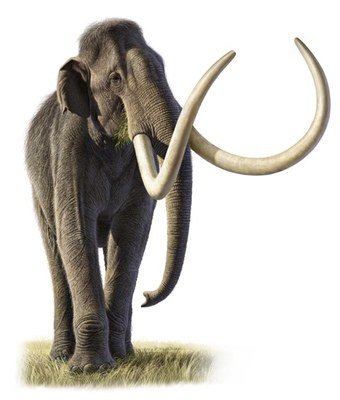North American Mammoth Diversity and Interbreeding
Here we report the sequencing of 67 new mammoths including non-Woolly specimens representing Columbian (Mammuthus columbi), Jeffersonian (Mammuthus jeffersonii), and pygmy (Mammuthus exilis) mammoths. In disagreement with the paleontological record, our analysis suggests that these mammoth species interbred, and may have resulted in specimens displaying intermediate Woolly-Columbian morphologies.
Apr 26, 2016
Article Title: Mammuthus Population Dynamics in Late Pleistocene North America: Divergence, Phylogeography, and Introgression
Authors: Jacob Enk, Alison Devault, Christopher Widga, Jeffrey Saunders, Paul Szpak, John Southon, Jean-Marie Rouillard, Beth Shapiro, G. Brian Golding, Grant Zazula, Duane Froese, Daniel C. Fisher, Ross D. E. MacPhee, and Hendrik Poinar
Front. Ecol. Evol., Vol. 4 (42), Apr 2016, DOI: 10.3389/fevo.2016.00042

Columbian mammoth. Image credit: Raul Martin
Abstract
After evolving in Africa at the close of the Miocene, mammoths (Mammuthus sp.) spread through much of the northern hemisphere, diversifying morphologically as they entered various habitats. Paleontologically, these morphs are conventionally recognized as species. In Pleistocene North America alone, several mammoth species have been recognized, inhabiting environments as different as cold tundra-steppe in the north and the arid grasslands or temperate savanna-parklands of the south. Yet mammoth phylogeographic studies have overwhelmingly focused on permafrost-preserved remains of only one of these species, Mammuthus primigenius (woolly mammoth). Here we challenge this bias by performing a geographically and taxonomically wide survey of mammoth genetic diversity across North America. Using a targeted enrichment technique, we sequenced 67 complete mitochondrial genomes including non-primigenius specimens representing Mammuthus columbi (Columbian mammoth), Mammuthus jeffersonii (Jeffersonian mammoth), and Mammuthus exilis (pygmy mammoth), including specimens from contexts not generally associated with good DNA preservation. While we uncovered clear phylogeographic structure in mammoth matrilines, their phylogeny as recovered from mitochondrial DNA is not compatible with existing systematic interpretations of their paleontological record. Instead, our results strongly suggest that various nominal mammoth species interbred, perhaps extensively. We hypothesize that at least two distinct stages of interbreeding between conventional paleontological species are likely responsible for this pattern—one between Siberian woolly mammoths and resident American populations that introduced woolly mammoth phenotypes to the continent, and another between ecomorphologically distinct populations of woolly and Columbian mammoths in North America south of the ice.